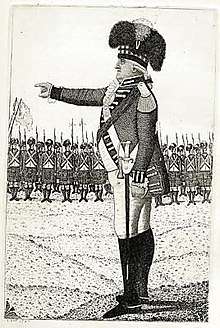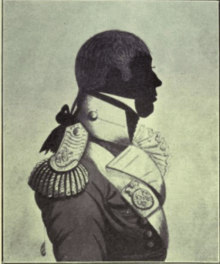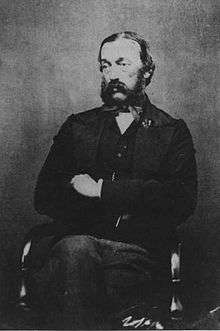Fencibles
The Fencibles (from the word defencible) were British regiments raised in the United Kingdom and in the colonies for defence against the threat of invasion during the Seven Years' War, the American War of Independence, the French Revolutionary Wars, the Napoleonic Wars and the War of 1812 in the late 18th and early 19th centuries. Usually temporary units, composed of local recruits and commanded by Regular Army officers, they were usually confined to garrison and patrol duties, freeing Regular Army units to perform offensive operations. Most fencible regiments had no liability for overseas service.
They included naval forces known as "River Fencibles", made up of boatmen on the Thames and other southern English towns and cities, as well as Sea Fencibles, who, among their other duties, manned small commercial vessels converted to coastal defence.[1]
History

The first regiments were raised in Scotland in 1759. In England county militia regiments were raised for internal defence in the absence of the regular army; but it was not deemed prudent to extend the system to Scotland, the inhabitants of which, it was supposed, could not yet be safely entrusted with arms because of The 'Fifteen' and The 'Forty-Five' rebellions. Groundless as the reasons for this caution undoubtedly were in regard to the Lowlands, it would certainly have been hazardous at a time when the Stuarts and their adherents were still plotting a restoration to have armed the clans.[2]
Unlike the militia regiments which were raised by ballot, the Fencibles were to be raised by the ordinary mode of recruiting, and like the regiments of the line, the officers were to be appointed, and their commissions signed by the king.[2]
Most fencible regiments had no liability for overseas service however there were exceptions. Ireland while not united with the Kingdom of Great Britain until 1801 was the destination for several British fencible regiments during the Rebellion of 1798 where they fought in some minor pitched battles. The 3rd Argyllshire Regiment, who like some other fencible regiments had terms of service that extended to any part of Europe, garrisoned Gibraltar (as did Banffshire Fencibles, 2nd Argllshire Fencibles, and the Prince of Wales Own Fencibles[3])[4][5] The Dumbarton Fencibles Regiment was raised in Scotland, garrisoned Guernsey, fought in Ireland, and detachment escorted prisoners to Prussia.[6] The Ancient Irish Fencibles were sent to Egypt where they took part in the operations against the French in 1801.[7]
Fencible regiments were less effective than regular troops for military duties, with problems of lack of education and disease. In Ireland the men would take part in inter-regimental brawls and attacks on soldiers. Some regiments of Fencibles, however, were noted for exceptional service.[8]
Timeline
Highland Fencibles
The Scottish Highlands supplied fencible regiments for most of the second half of the 18th century. The first regiment raised was the Argyle Fencibles in 1759 and the last was the MacLeod Fencibles in 1779. In all over 20 regiments were created, although they were not all in existence at the same time. Some Highland fencibles regiments saw action in the Irish Rebellion of 1798, while other performed garrison and policing duties in Britain, Ireland, the Channel Islands and Gibraltar.[9]
American Revolutionary War
The Royal Fencible Americans was a Loyalist unit raised by the British in Nova Scotia in 1775, that successfully withstood an attack by Patriot forces under Jonathan Eddy at the Battle of Fort Cumberland.[10]
Irish Rebellion of 1798
Fencibles were raised for the entirety of the British Isles. In Thomas Flanagan's The Year of the French Fencibles are raised by Cornwallis and other generals to combat the Irish Rebellion of 1798.
French Revolutionary and Napoleonic Wars
Fencible units were raised in the United Kingdom during the early years of the war. This included not only land regiments but also the Sea Fencibles (raised in 1798 and disbanded in 1810). By the Peace of Amiens in 1802, all Fencible Regiments had been disbanded and those members willing to continue serving had been transferred to regular army regiments. When the Napoleonic Wars resumed the British used alternative methods to defend the Home Nations (see for example the Additional Forces Act, July 1803) and with the exception of the Royal Manx Fencibles (third corps, 1803–1811) no more fencible regiments were raised for home defence.
War of 1812

In the early years of the 19th Century, regiments of Fencibles were raised in the Canadas, New Brunswick, Newfoundland, and Nova Scotia. The regiments were liable for service in North America only (although the New Brunswick Fencibles volunteered for general service and became the 104th Regiment of Foot in the regular army). All but one of these regiments saw action in the War of 1812. The regiments were disbanded in 1816 and 1817, after the War of 1812. Although the units were disbanded, several regiments in Canada continue to perpetuate their historic lineage.
Most of the Fencible regiments were formed in 1803, including the Nova Scotia Fencibles, the Canadian Regiment of Fencible Infantry (perpetuated by the Royal 22nd Regiment), the Royal Newfoundland Fencibles (perpetuated by the Royal Newfoundland Regiment), and the New Brunswick Regiment of Fencible Infantry (perpetuated by the Royal New Brunswick Regiment). The Glengarry Light Infantry Fencibles (perpetuated by the Stormont, Dundas and Glengarry Highlanders) was formed in February 1812, several months prior to the war. In addition to these Canadian units, the Michigan Fencibles, a small unit of 45 men was raised at Fort Mackinac in 1813.[11]
Bombay Fencibles
The Bombay Fencibles were raised in 1799 by the following order of the Bombay Army: "A regiment consisting of two battalions of natives to be, under the denomination of the 'Bombay fencibles,' raised from the inhabitants of Bombay, Salsette, and Caranjah, on condition of not being liable to serve out of the said bounds; at the * pay to each private of 5 rupees 2 quarters per month, besides clothing: which last they will receive from the honorable company".[12]
The 5th battalion of the Maratha Light Infantry was raised in December 1800 from the Bombay Fencibles as the 1st Battalion, the 9th Regiment of Bombay Native Infantry.
Malta
The Royal Malta Fencible Regiment was in existence from 1815 to 1861 when it became the Royal Malta Fencible Artillery until 1881. The term 'Fencible' was dropped in 1889 and it became the Royal Malta Artillery.[13][14]
New Zealand Wars

In 1847 the Royal New Zealand Fencible Corps were raised and sent to New Zealand for the defence of the early settlers there. They were settled in four new outlying villages around Auckland, (then the capital), at Onehunga, Otahuhu, Panmure, and Howick, the largest of the four. About 75 fencibles and their sons took part as militia in the 1860s New Zealand Wars.[15][16]
See also
- Army Reserve (United Kingdom), the modern-day equivalent
- British Volunteer Corps
- Canadian forces Primary Reserve
- History of the British Army
- Home Guard (United Kingdom)
- Militia (British Dominions and Crown Colonies)
- Militia (Great Britain)
- Militia (United Kingdom)
- Territorial Army
- Yeomanry
Notes
- National Maritime Museum 2011.
- Browne 1854, p. 368.
- Musteen 2011, p. 218 (note 540).
- Browne 1854, p. 384.
- Scobie 1914, p. 355.
- Scobie 1914, p. 356.
- Scobie 1914, p. 362.
- Bartlett & Jeffery 1997, p. .
- Browne 1854, pp. 368–384.
- Loyalist Institute: Royal Fencible Americans, Proposal to Raise a Battalion, 1775
- Chartrand & Embleton 1998, p. 41.
- Moor 1801, p. 6.
- Armed Forces of Malta 2015a.
- Armed Forces of Malta 2015b.
- Herald 2010.
- Alexander et al. 1997, p. 112.
References
- Alexander, R.; Gibson, G.; La Roche, A.; Waiuku, Deed (1997), The Royal New Zealand Fencibles, Auckland: The New Zealand Fencible Society Inc, ISBN 0473047160
- Bartlett, Thomas; Jeffery, Keith (1997), A Military History of Ireland, Cambridge University Press
- Chartrand, René; Embleton, Gerry (1998), British Forces in North America 1793–1815, London: Osprey, p. 41, ISBN 1855327414
- "Auckland: Soldiers of fortune", The New Zealand Herald, 26 August 2010, archived from the original on 24 October 2012, retrieved 5 February 2011
- "Royal Malta Fencible Regiment (1815–1861)", Armed Forces of Malta, 16 October 2015a, retrieved 22 August 2017
- "Royal Malta Fencible Artillery (1861–1881)", Armed Forces of Malta, 16 October 2015b, retrieved 22 August 2017
- "Prize medal, River Fencibles 1804 (MED0240)". National Maritime Museum, Greenwich, London. 2011. Archived from the original on 8 June 2011. Retrieved 5 February 2011.
- Moor, Captain Edward (1801), A compilation of all the ... orders ... 1750 to ... 1801 ... of the Bombay, Bombay: Courier and Gazette Presses, p. 6
- Musteen, Jason R. (2011), Nelson's Refuge: Gibraltar in the Age of Napoleon, Naval Institute Press, p. 218, ISBN 9781612510842
- Scobie, Ian Hamilton Mackay (1914), An old highland fencible corps : the history of the Reay Fencible Highland Regiment of Foot, or Mackay's Highlanders, 1794–1802, with an account of its services in Ireland during the rebellion of 1798, Edinburgh: Blackwood, pp. 353–364
Attribution:
